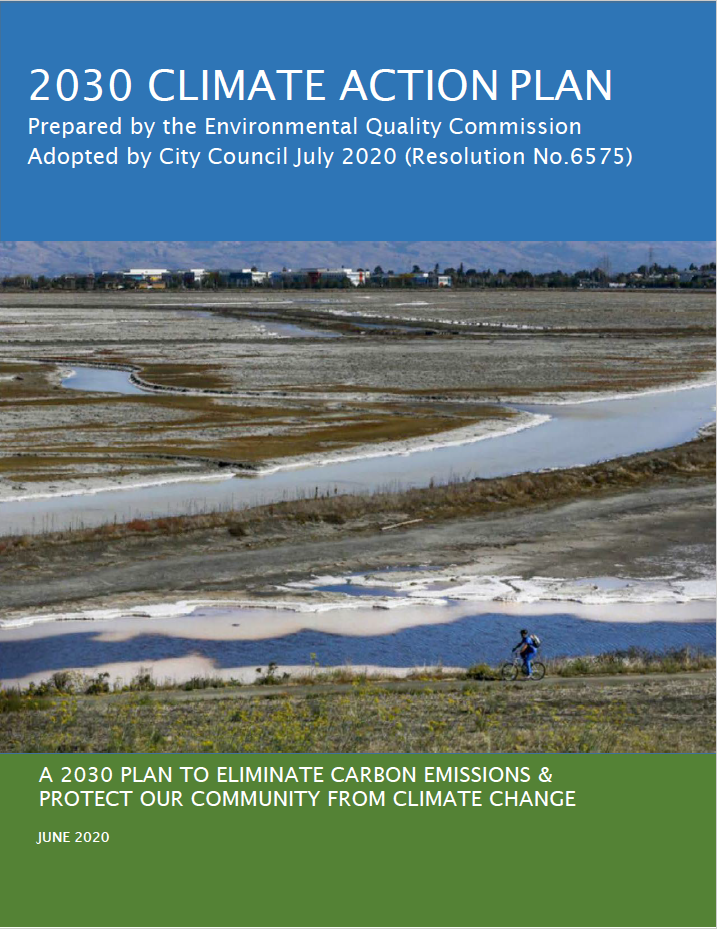The Story of Menlo Park’s Unprecedented 2020 Climate Action
At Thrive Alliance’s October 15 Environment & Sustainability panel “Menlo Park’s Recent CAP Adoption: Carbon Zero by 2030” (video replay) councilmembers, staff, and community leaders shared learnings and best practices on the path to groundbreaking climate action. The meeting was co-hosted by the Sierra Club Loma Prieta Chapter.
“Think bold! It’s time to act in unprecedented ways,” said Josie Gaillard, Menlo Park Environmental Quality Commissioner (EQC) about the city’s recently adopted Climate Action Plan (CAP).
With this overarching theme, the Menlo Park council by resolution approved their 2030 Climate Action Plan on July 14, 2020. Unprecedented indeed, this act makes Menlo Park one of the first U.S. cities with a carbon neutral by 2030 goal. The city also set the standard for aggressive green building codes, aka Reach Codes, with its July 2019 adoption of a nearly all-electric Ordinance for new residential and commercial buildings.
Menlo Park is now one of the first U.S. cities with a carbon neutral by 2030 goal.
Insider Experts or Outside Consultants?
Importantly, the CAP was crafted without outside consultants, making it truly the community’s work. Given city staff’s focus on other critical priorities, seasoned and skilled residents played a crucial role in architecting the masterfully researched document.
But doesn’t every Bay Area city also have passionate residents ready to do the same? Given local academic and technology aptitude, it’s likely we do. The six panelists (pictured here) challenged other cities to, “harvest the talent and skills of the citizens who are interested in getting involved.”
“People are aware and trying to make sustainability change, but policymakers were hesitant to implement plans,” said councilmember Ray Mueller. Citing the city’s esteemed nonprofit, Menlo Spark, and its highly respected director, Diane Bailey, Mueller added that community leadership made a huge difference.
Referencing public-private teamwork, Mueller noted it’s easier to adopt bold climate action when “policymakers see the public believes in this work and it’s creating an impact.” He praised the city’s outstanding workforce, including Sustainability Manager Rebecca Lucky, and added “Menlo Park’s professional staff provided a lot of support, expertise, and commitment.”
Keep It Short
Principally authored by Gaillard and committee members Tom Kabat and James Payne, the CAP succinctly outlines a one-year workplan, with expectation of annual iteration, that includes six key strategies:
Building Electrification
EV & Gasoline Sales
EV infrastructure
Reduce VMT
Municipal Ops
Climate Adaption
After reading dozens of CAPs from around the U.S., the EQC concluded brevity was a key to Menlo Park’s 10-page plan. “If you want to move people in bold ways, keep it short and readable,” said Gaillard. “When you present (to council), assume they have read nothing.”
Making it sound easy, the EQC actually spent hundreds of hours studying and creating background documents and spreadsheets that substantiate the bold plan. The seven person EQC includes engineers and chemists as well as energy and business leaders. This talent made it easy for staff and council to empower the resident sourced commission, another credit to community teamwork.
Without Compromise
Early in the CAP development process, when the team realized that a gas furnace lasts an average of 30 years, it suddenly became clear that one of the most important jobs of the CAP was to lay out a plan for stopping the continued stranding of fossil fuel assets in Menlo Park.
The journey, however, did not unfold as planned, with the pandemic and budget cuts requiring a scaled back version of the initial vision. The comprehensive December 2019 EQC staff report proposed 10 CAP strategies, 70 actions, and new staff hires over three years.
“What compromises did you make?” asked an attendee in Thrive’s October community meeting. Kabat and Gaillard responded that, while reigning in the scope because of COVID-19, the EQC decided not to compromise in their recommendations. Rather, they chose to deliver a plan to address the considerable challenge, and let the council decide what’s politically feasible.
Councilmember Betsy Nash impressed the importance of climate action to economic and housing policy that is vital to the entire community. “CAP and environmental activism are well integrated with housing and jobs.”
Regarding the climate’s intersection with equity concerns, she added sustainability action is “making an impact on all Bay Area communities, including those vulnerable to rising water.”
Sparking Action
Although she tried to push credit to other panelists, the conversation led back to Diane Bailey’s work through Menlo Spark nonprofit. Founded in 2104 by community leaders Mitch Slomiak and Chris DeCardy, former Menlo Park Environmental Quality Commissioners, who attended almost every related council and commission meeting, the organization has pushed a bold vision from the start. Backing Bailey is a board of directors full of Menlo Park trailblazers including State Senate District 13 candidate Josh Becker.
For those that don’t know about Menlo Spark, it’s the model for local climate change. Check out more info at their website and its related campaign for fossil free buildings in Silicon Valley.
Good Luck
Although she may be less visible because of her savvy behind the scenes guidance, Sustainability Manager Rebecca Lucky provided essential policy and procedural guidance to direct the 12-month journey from early vision to CAP adoption.
Providing the attendees with important wisdom, Lucky recommended other jurisdictions to “get the CAP in your city’s annual plan with other top priorities.” Adding, “find the points where local government intervention is warranted,” noting that the housing crisis and traffic congestion are directly related to greenhouse gas emissions.
Menlo Park Wants You!
With this confluence of passion, intelligence and teamwork in Menlo Park, is it even possible for other cities replicate?
With Gaillard’s generous offer, the answer is a resounding yes. “We’ve open-sourced our work and are making everything we’ve done available for other cities to use.”
To learn more, the CAP authors and architects are easily reachable and ready to help other Bay Area cities craft similarly bold plans. So, send them a note or give them a call:
Rebecca Lucky, rllucky@menlopark.org, (650) 330-6765
Josie Gaillard, josie_gaillard@me.com, (510) 393-5193
Tom Kabat, tomgkabat@gmail.com, (650) 924-8525
Diane Bailey, diane@menlospark.org, (650) 281-7073
Thrive’s monthly Environment & Sustainability Community meetings are supported by Midpeninsula Regional Open Space District and Peninsula Clean Energy.
Link to Additional Resources
EQC’s CAP presentation to city council (6/16/20) - see minutes 8-37 plus watch additional video footage played during open segment
EQC’s final presentation to city council (7/14/20) - starts at 2:04:00 and lasts for about 25 minutes
Rebecca Lucky Menlo Park CAP 2030 presentation to RICAPS (7/28/20)
Menlo Park 2019 Reach Code for new commercial & residential buildings
Link to Speaker Bios
Ray Mueller - City Council Member, Menlo Park - LinkedIn, City of Menlo Park
Betsy Nash - City Council Member, Menlo Park - LinkedIn, City of Menlo Park
Rebecca Lucky - Sustainability Manager, Menlo Park - LinkedIn, City of Menlo Park
Josie Gaillard - Environment Quality Commissioner, Menlo Park - LinkedIn, City of Menlo
Tom Kabat - Environment Quality Commissioner, Menlo Park - LinkedIn, SunWork
Diane Bailey - Menlo Spark Executive Director, Menlo Spark - LinkedIn, Menlo Spark


















